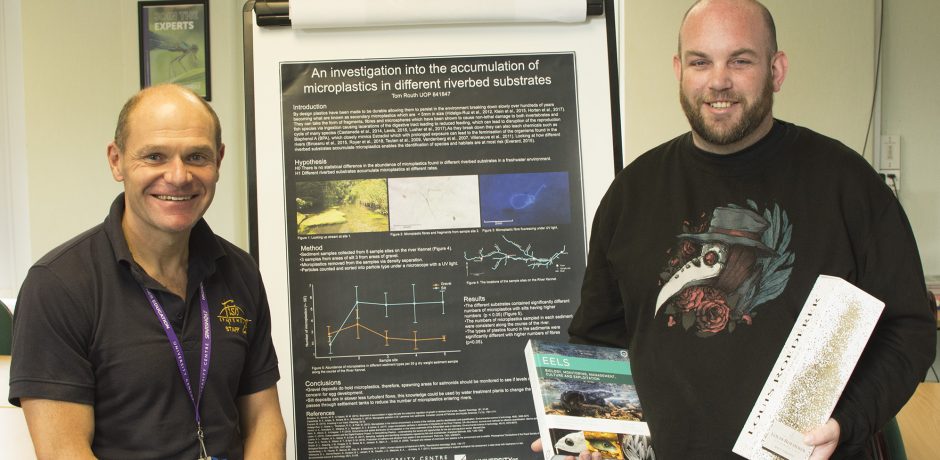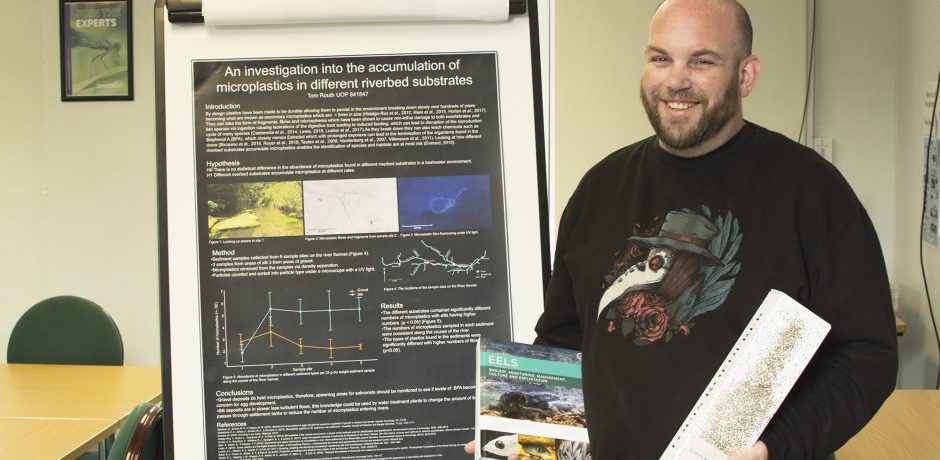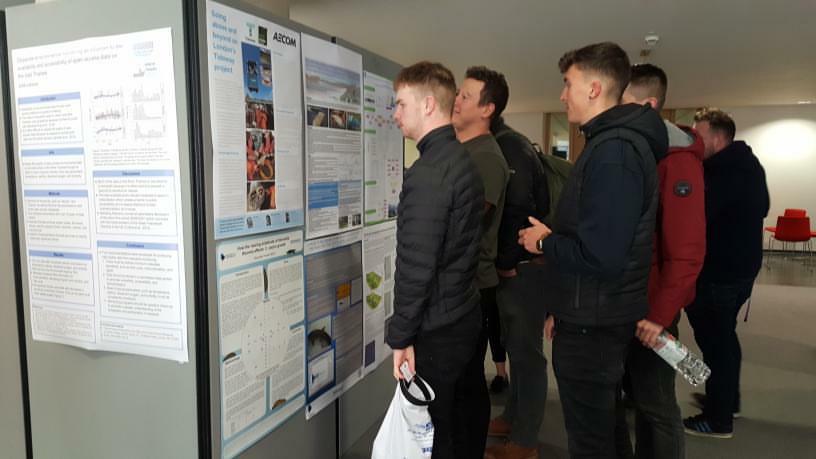BSc (Hons) Aquaculture and Fishery Management Degree, third year students have recently had a fantastic few days learning and networking at the Institute of Fisheries Management (IFM) 50th Anniversary Conference.
Over the three days, our students were able to hear from some fantastic speakers from organisations such as the Environmental Agency, the IFM, Cefas and Sustainable Eel Group to name a few. UCS Students also were able to take part in some very interesting field trips that included a choice of exploring Attenborough Nature Reserve, The Trent Gateway Project or Calverton Fish Farm, the Environment Agency’s National Coarse Fish Rearing Unit.
Although, the highlight of the trip for many of our students was a networking and poster session aboard the Nottingham Princess, along the River Trent. A number of posters were displayed, three of which were from Sparsholt Students Tom Routh, Piran Crago and Macauley Powell.
Tom Routh, was awarded the prize for ‘Best Poster’ for his investigation into the accumulation of microplastics in different riverbed substrates. Whilst Piran Crago, collected the ‘Highly Commended’ second place award for his study on two species of sea lice and its impact on the Hebridean sea trout population. Tom and Piran, came at the top of 27 poster submissions from a range of industry and academic institutions – a very prestigious feat that we are incredibly proud of!
George Hide (B.Sc. course tutor) said, “Visiting the IFM Conference was a fantastic opportunity for the students to increase their knowledge and to make industry contacts. I was particularly delighted that the quality of the research carried out by Sparsholt students was recognised at the conference.”
Congratulations again to Tom, Piran and Macauley on their excellent work!
Become an expert in Aquaculture – join us in 2020
If you would like to read more, find the abstracts from our students work below:
An investigation into the accumulation of microplastics in different fluvial bed sediments of the River Kennet.
Tom Routh
Sediment samples were collected from 6 sites on the river Kennet during June of 2018 to help establish if the accumulation of microplastic particles was the same between different fluvial bed sediments. All sampling took place on the same date, with triplicate samples taken from both silt and gravel deposits at each location.
Density separation was used to extract the microplastic particles from each sample and counted. There were significant differences found between sediment types (p<0.05) with silt deposits containing a higher number of microplastic particles.
Different particle types also differed significantly (p<0.05) with 72% of the total microplastics sampled being fibres with the remainder being fragments; no microspheres were found in the samples. The findings of this trial indicate that there could be a saturation point for each sediment type with total numbers of particles not changing between each sample site.
A study on two species of sea lice and its impact on the Hebridean sea trout (Salmo trutta trutta) population
Piran Crago
The relationships between the aquaculture industry and the decrease of wild salmonid populations, are a controversial subject. Using data collected between 2016 and 2018 from sweep-netting undertaken by the Outer Hebrides Fisheries Trust, the impact of sea lice infestations on wild sea trout (Salmo trutta trutta), was investigated. Sea lice are a natural salmonid parasite, and feed on skin, mucus, and muscle of their host. An infection of 0.7 sea lice/g of fish can cause behavioral changes, osmoregulatory breakdowns, and affects the feeding of the fish. The Sea Trout population decreased slightly over the time of this survey. In salmon farm areas, sea lice levels on wild sea trout are typically higher, and more variable than locations without farms. There was a significant relationship (P<0.001) between the proximity of the nearest farm and the number of lice/g fish. There was also a significant negative linear relationship between the number of sea lice/g fish and the condition factor of the sea trout. This study is only a first step towards understanding the decrease of sea trout populations in the Outer Hebrides; other factors such as predators, river continuity and climate change need further investigation.
An investigation into the effect the rearing substrate of Black Soldier Fly (BSF) (Hermetia illucens) has on the growth performance of Cyprinus carpio.
Macauley Powell
A four-week feed trial using 90 C. carpio averaging 4.45g was conducted to investigate the effect the rearing substrate used for BSF has on the growth performance factors (FCR, PER, SGR, & CF) of C. carpio. 2 identical diets were formulated using 100% insect meal at a 40% inclusion, changing the insect meal to either H. illucens larvae reared in pig manure (BSFP) or H. illucens reared in cow manure (BSFC) which were grown over a 12 day period pre trial. A further control diet (BSFF) was formulated using identical inclusions, however exchanging the insect meal for fishmeal. Diets were fed to triplicate sets of C. carpio, housed in identical 45L tanks at 3%BW per day. Fish were fed twice a day, morning and afternoon. Tanks were weighed weekly to update feed rations. Results indicate rearing substrate of H. illucens to significantly affect PER, FCR, and SGR of C. carpio (p<0.05). CF of C. carpio was not effected during this trial (p>0.05). BSFP produced significantly better FCRs (2.24+/-0.13), PERs (1.79+/-0.11) and SGRs (1.10+/-0.06) compared to BSFC FCRs (2.74+/-0.13), PERS (1.48+/-0.09) and SGRs(0.91+/-0.05). Because of this, a conclusion can be made that the choice of rearing substrate for H. illucens is important for both BSF and carp producers. This information can be used to optimise H. illucens production to ensure more sustainable insect meal diets can be used as effectively as possible for C. carpio production.


